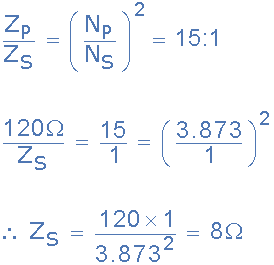In addition to increasing or decreasing the signal voltage, the transformer also has another very useful characteristic, namely isolation. Since there is no direct electrical connection between the primary and secondary windings of the transformer, complete electrical isolation is provided between the input and output circuits of the transformer. The audio transformer connected between the amplifier and the speaker can also take advantage of this isolation characteristic.
In this section's introduction to transformers, we learned that a transformer is an electrical device that allows sinusoidal input signals (such as audio signals or voltages) to generate output signals or voltages without the need for a physical connection between the input side and the output side. This coupling is achieved by winding two (or more) coils (referred to as windings) of insulated copper wires around a soft magnetic core.
Audio transformer
When the AC signal is applied to the primary input winding, due to the inductive coupling of the soft iron core, the corresponding AC signal will appear on the output secondary winding. The turns ratio between the input and output coils determines the increase or decrease of the applied signal as it passes through the transformer.
Then, an audio transformer can be regarded as either a boost type or a buck type, but an audio transformer is not wound to generate a specific voltage output; rather, it is mainly used for impedance matching. In addition, a transformer with a turns ratio of 1:1 does not change the voltage or current level but isolates the primary circuit from the secondary side. This type of transformer is usually called an isolation transformer.
Transformers are not intelligent devices, but they can be used as bidirectional devices, allowing the normal primary input winding to become the output winding and the normal secondary output winding to become the input. Due to this bidirectional characteristic, transformers can provide signal gain when used in one direction and signal loss when used in the opposite direction. To help match the signal or voltage levels between different devices.
It should also be noted that a single transformer can have multiple primary or secondary windings, and these windings can also have multiple electrical connections or "taps" along their length. The advantage of multi-tap audio transformers is that they offer different electrical impedances and different gain or loss ratios, making them suitable for impedance matching in amplifiers and speaker loads.
As the name suggests, an audio transformer is designed to operate within an audio frequency band, and thus can be applied to the input stage (microphone), output stage (speaker), inter-stage coupling, and impedance matching of amplifiers. In all cases, the frequency response, primary and secondary impedances, as well as power capability need to be taken into consideration.
The design of audio and impedance matching transformers is similar to that of low-frequency voltage and power transformers, but their operating frequency range is much wider. For example, the voice range from 20Hz to 20kHz. Audio transformers can also conduct direct current in one or more windings, and are used in digital audio applications as well as for converting high-frequency voltage and current levels.
Audio transformer impedance matching
One of the main applications of audio transformers is impedance matching. Audio transformers are highly suitable for balancing amplifiers and loads with different input/output impedances to achieve power transmission.
For instance, the typical impedance range of a speaker is 4 to 16 ohms, while the impedance of the output stage of a transistor amplifier can be as high as several hundred ohms. A typical example is the LT700 audio transformer, which can be used in the output stage of an amplifier to drive speakers.
We know that for a transformer, the ratio of the number of turns (N P) in the primary winding to the number of turns (N S) in the secondary winding is called the "turns ratio". Since the same amount of voltage is generated within each single coil of the two windings, the ratio of the primary to secondary voltages (V P /V S) will be the same as the turns ratio.
An impedance-matched audio transformer always gives the impedance ratio from one winding to another by the square of its turns ratio. That is to say, their impedance ratio is equal to the square of their turns ratio, and also equal to the square of their primary to secondary voltage ratio, as shown in the figure.
Impedance ratio

Audio transformer impedance ratio
Among them, ZP is the impedance of the primary winding, ZS is the impedance of the secondary winding, (N P /N S) is the turns ratio of the transformer, and (V P /V S) is the voltage ratio of the transformer.
For instance, if the turns ratio (or voltage ratio) of an impedance-matched audio transformer is 2:1, its impedance ratio is 4:1.
Audio Transformer Example No. 1
An audio transformer with an impedance ratio of 15:1 is needed to match the output of the power amplifier and the speaker. If the output impedance of the amplifier is 120Ω. Calculate the nominal impedance of the speaker required for power transmission.

Then the power amplifier can effectively drive the 8-ohm speaker.
Audio 100V line transformer
Another very common application of impedance matching is for 100-volt line transformers, which are used to transmit music and voice through public address amplification systems. These types of ceiling speaker systems use multiple speakers at a certain distance from the power amplifier.
By using a line isolation transformer, any number of low-impedance speakers can be connected together so that they can correctly load the amplifier, thereby providing impedance matching between the amplifier (source) and the speaker (load) and achieving power transmission.
Since for a given cable resistance, the power loss of the signal through the speaker cable is proportional to the square of the current (P = I ² R), the output voltage of the amplifier used for public broadcasting (PA) or loudspeakers uses a standard constant voltage output level, that is, a peak of 100 volts (root mean square 70.7 volts).
For instance, a 200-watt power amplifier driving an 8-ohm speaker provides 5 amperes of current, while a 200-watt power amplifier using a 100-volt line only offers 2 amperes of current at full power. Therefore, smaller-sized cables can be used. However, please note that only when the power amplifier of the drive line operates at full rated power will there be a 100-volt voltage on the line; otherwise, the power (lower volume) and line voltage will decrease.
Therefore, for a 100V (70.7V rms) line speaker system, the line transformer boosts the audio output signal voltage to 100 volts so that the transmission line current of the given power output is relatively low, thereby reducing signal loss and allowing the use of cables with smaller diameters or specifications.
Since the impedance of a typical speaker is usually low, each speaker connected to a 100V line uses an impedance-matching step-down transformer (commonly known as a line-to-voice coil transformer), as shown in the figure.
100V transmission line transformer

100V line transformer
Here, the amplifier uses a boost transformer to provide a constant 100-volt transmission line voltage at a lower current under a given power output. The speakers are connected in parallel, and each speaker has its own impedance-matching step-down transformer to reduce the secondary voltage and increase the current, thereby matching the 100V line with the low impedance of the speakers.
The advantage of using this kind of audio transmission line is that even if multiple individual speakers, amplifiers or other such sound actuators have different impedance and power handling capabilities, they can still be connected to a single line. For example, the power is 5 watts at 4 ohms, or 20 watts at 8 ohms.
Impedance matching transformer
Typically, a transmission line matching transformer has multiple connection points on the primary winding, known as tap points, which allow for the selection of an appropriate power level (and volume) for each individual speaker. In addition, the secondary winding also has similar tap points, providing different impedances to match the impedance of the connected speaker.
In this simple example, a 100V line-to-speaker transformer can drive a 4, 8 or 16-ohm speaker load on the secondary side, with the rated power of the amplifier on the primary side being 4, 8 and 16 watts respectively, depending on the selected tap. In fact, the PA system line transformer can be selected for any combination of series and parallel speaker loads, with a power handling capacity of up to several kilowatts.
However, in addition to constant voltage impedance matching line transformers, audio transformers can also be used to connect low-impedance or low-signal input devices (such as microphones, rotary coil pickups, line inputs, etc.) to amplifiers or preamplifiers.
Since input audio transformers must operate over a wide frequency range, they are usually designed to cause the internal capacitance of their windings to resonate with their inductance, thereby improving their operating frequency range and allowing for the use of smaller transformer core sizes.
When we learned about audio transformers in this tutorial, we have seen that audio transformers are used to match the impedance between different audio devices. For example, they are used as line drivers to match the impedance between amplifiers and speakers, or between microphones and amplifiers.
Unlike power transformers that operate at low frequencies such as 50 or 60Hz, audio transformers are designed to work within the audio frequency range, that is, from approximately 20Hz to 20kHz or higher frequencies for RF transformers.
Due to the wide frequency band, the core of the audio transformer is made of special grades of steel, such as silicon steel or special ferroalloys with extremely low hysteresis loss.
One of the main disadvantages of audio transformers is their large size and high cost, but a smaller design can be achieved by using special magnetic core materials. This is because, generally speaking, the size of the transformer core will increase as the power supply frequency decreases.
免责声明: 本文章转自其它平台,并不代表本站观点及立场。若有侵权或异议,请联系我们删除。谢谢! Disclaimer: This article is reproduced from other platforms and does not represent the views or positions of this website. If there is any infringement or objection, please contact us to delete it. thank you! |


